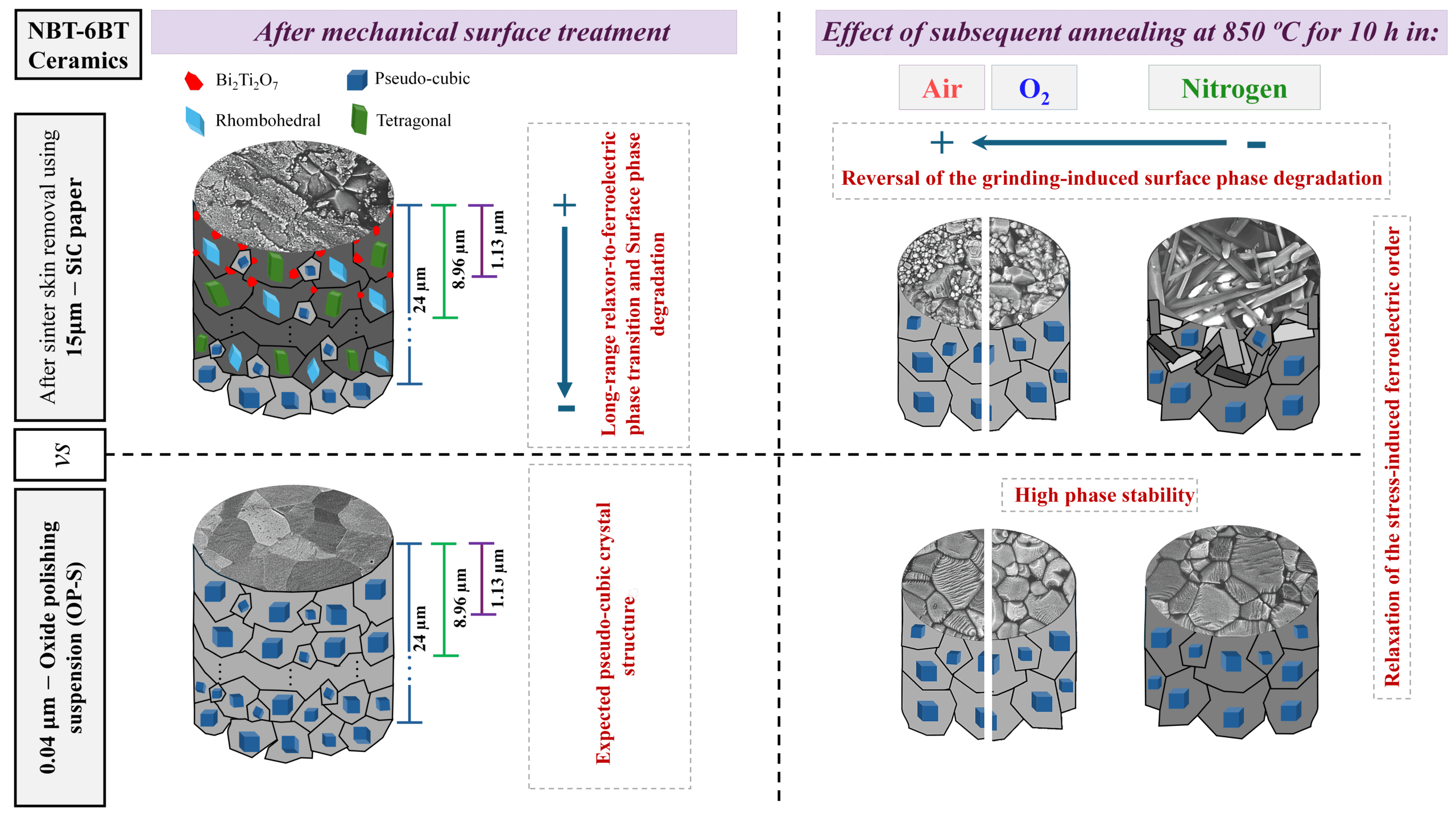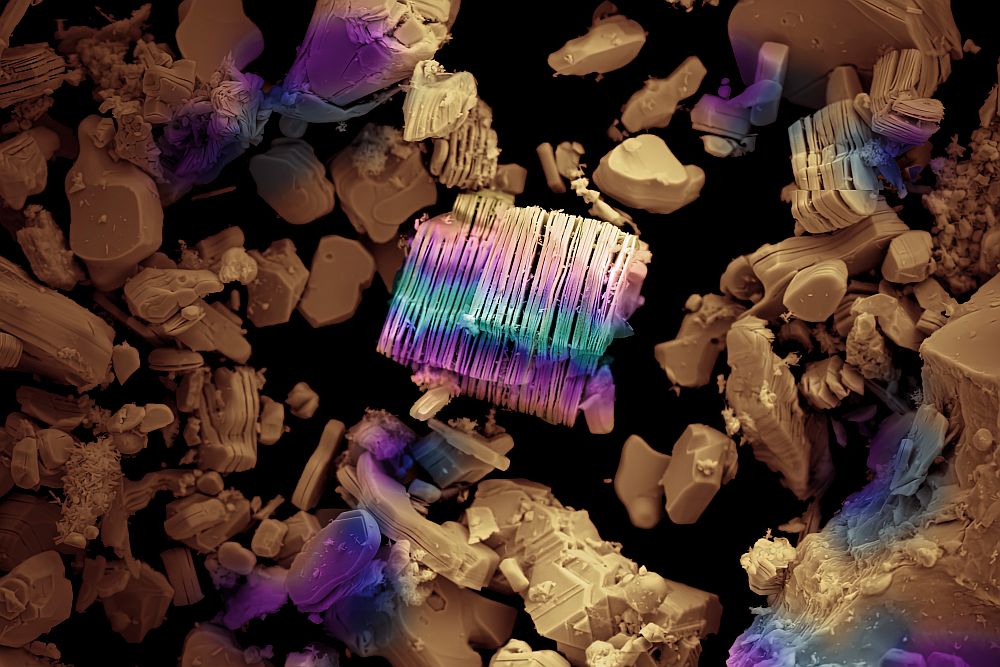
[Image above] Illustration showing the depth-dependent relaxor-to-ferroelectric phase transition and phase stability induced by coarse grinding versus fine polishing treatments in NBT-BT relaxor ferroelectric ceramics. Dependence of underlying further phase degradation and relaxation of stress-induced ferroelectric order with mechanical treatments under different environments is also shown. Arrows indicate the extent of the observed effects. Credit: Angélica María Benítez-Castro
My dad has told me stories from his time scuba diving in college and how surprisingly quickly the ocean quiets down as you dive below the surface. Regardless of the wave action taking place above, once you reach a depth of about 100 feet (30 meters), the effects from the surface are minimal except in extreme storm situations.
This difference between the surface and deeper wave action of the ocean can serve as a good analogy for the ferroelectric and piezoelectric properties in bulk materials. While these properties are generally assumed to be relatively uniform within the material, at the surface, various effects from physical, chemical, and mechanical factors can influence domain formation and evolution, potentially leading to distinct ferroelectric and piezoelectric behaviors.
Mechanical grinding is one of the factors that can induce stress and alter the surface domain structure. Generally, for structure–property characterization, researchers will grind and polish the samples to remove sintering-induced surface chemical changes and ensure uniform thickness. They will then heat the sample above its respective paraelectric-to-ferroelectric transition temperature (commonly known as the Curie temperature in typical ferroelectrics, such as barium titanate). This approach is believed to help minimize the possibility of stress-induced effects by resetting the domain structure due to the loss of polarization.
But as scientists have learned time and again, generally accepted standards of practice are not infallible. Sometimes accidental discoveries will uncover the shortcomings of established methods.
In a recent paper, researchers from Friedrich-Alexander University of Erlangen-Nürnberg (FAU Erlangen-Nürnberg) in Germany and the Center for Research and Advanced Studies of the National Polytechnic Institute (CINVESTAV) in Mexico showed that more attention should be paid to the mechanical polishing and heat treatment steps used to prepare ferroelectric and piezoelectric samples for surface-sensitive probing techniques.
Neamul Hayet Khansur, previously at FAU Erlangen-Nürnberg and now assistant professor in the Department of Materials Science and Engineering at Case Western Reserve University, explains in an email that the genesis of this publication came about from a casual discussion regarding X-ray diffraction studies of bulk sintered ceramics with Angélica María Benítez-Castro, first author and joint Ph.D. student at FAU Erlangen-Nürnberg and CINVESTAV.
“While preparing ceramic samples for her Ph.D. project, Angélica observed that the X-ray diffraction patterns varied significantly depending on the surface finishing quality, such as using 15-micron grinding steps or fine colloidal polishing,” Khansur says. “Moreover, the grinding and polishing-induced effects could not be minimized even after heating the samples above 600°C for more than four hours.”
“This effect was particularly pronounced in samples with an average cubic structure in their as-processed states,” he continues. “Based on this initial observation, she began developing and exploring further experimental steps to investigate this phenomenon.”
Benítez-Castro worked with several professors as well as university technicians to develop and test some hypotheses that could explain the phenomenon.* In an email, she gives a special thanks to Eva Springer, a technician at FAU Erlangen-Nürnberg, who helped her design the experiments in such a way to assure reproducibility.
The results of these efforts are reported in the recent paper, which uses the polycrystalline piezoceramic sodium bismuth titanate–barium titanate (NBT–6BT) as a model system.
The authors drew two main conclusions about ferroelectric and piezoelectric sample preparation from this experiment:
Rough grinding can induce new secondary phases
While grinding was supposed to help remove the sintering-induced chemical changes on the NBT–6BT surface, rough grinding with 15 μm-grit silicon carbide abrasive paper instead resulted in the formation of new secondary phases. Specifically,
- Rough grinding increased the propensity of the chemically changed surface to degrade into a bismuth-rich phase with a pyrochlore structure within the outermost portion of the surface (~1.13 μm).
- Rough grinding triggered a long-range, relaxor-to-ferroelectric phase transition, resulting in the formation of a phase-modulated structure that extended approximately 24 μm into the surface.
The authors attribute the formation of these phases to a combination of factors, including frictional force, local heating, and cooling media. However, further polishing with fine-grained diamond suspensions (9, 6, 3, and 1 μm) helped smooth out the mechanically induced damage and reveal the pseudocubic phase of the unmodified NBT–6BT.
Roughly polished surfaces are less stable than finely polished surfaces
Comparison of X-ray diffraction patterns for roughly and finely polished NBT–6BT samples were notably different, which the authors argue provide insight into the phase stability of the samples’ respective surfaces.
Specifically, “The [roughly polished] 15 μm samples exhibited the formation of secondary phases when subjected to O2 and N2 environments, while [finely polished] OP-S showed a small trace of a new formed phase in N2 only, inferring that the 15 μm crystal structure appears to be more unstable,” they write.
Considering these findings, scientists should pay closer attention to their sample preparation methodologies so it “mitigates the surface damage and reveals intrinsic properties, thereby enhancing structural stability when subjected to harsh environments,” the authors conclude.
In an email, Benítez-Castro says that after working on this study, “I firmly believe that many questions remain unanswered, and the truth is not always revealed in one single report.” She says that some of her colleagues in Germany, Mexico, and the U.S. are now working to improve understanding of different piezo- and ferroelectric systems and the proper processing protocols required for each.
Ultimately, “Making science is really challenging but extremely exciting when it is what you love to do,” she says.
The paper, published in Ceramics International, is “Mechanically induced surface damage and resulting thermal instability in polycrystalline 0.94Na1/2Bi1/2TiO3–0.06BaTiO3” (DOI: 10.1016/j.ceramint.2025.06.175).
*This publication is part of a larger project, supervised by Kyle Webber (FAU Erlangen-Nürnberg, Germany) and Juan Muñoz Saldaña (CINVESTAV-Querétaro, Mexico), that aims to develop compositional mapping of a more complex piezoelectric ternary system. The results of this project will soon be published and reported on CTT.
Author
Lisa McDonald
CTT Categories
- Basic Science
Related Posts
‘Fairy circles’ may help mark natural underground hydrogen deposits
September 18, 2025


